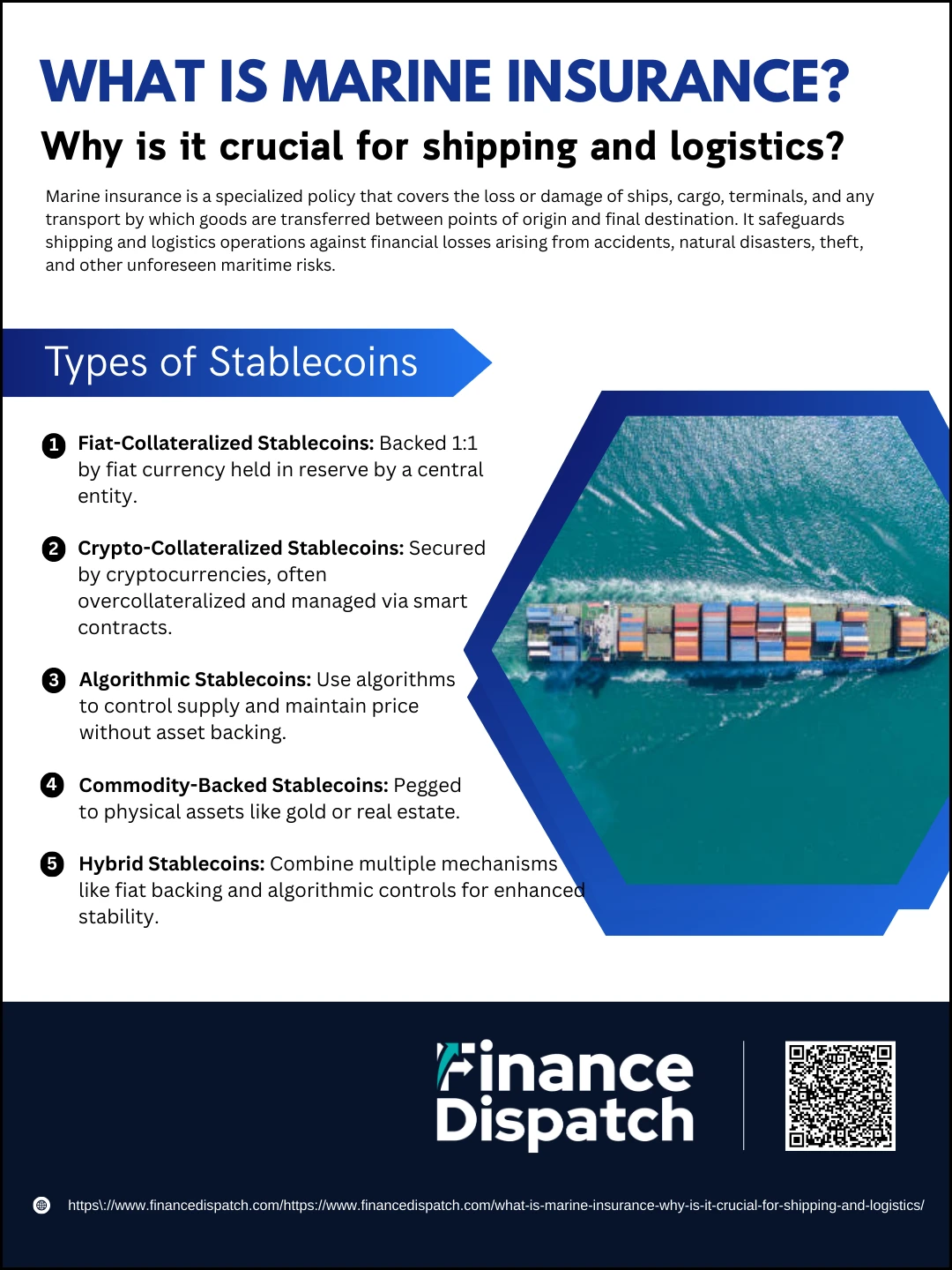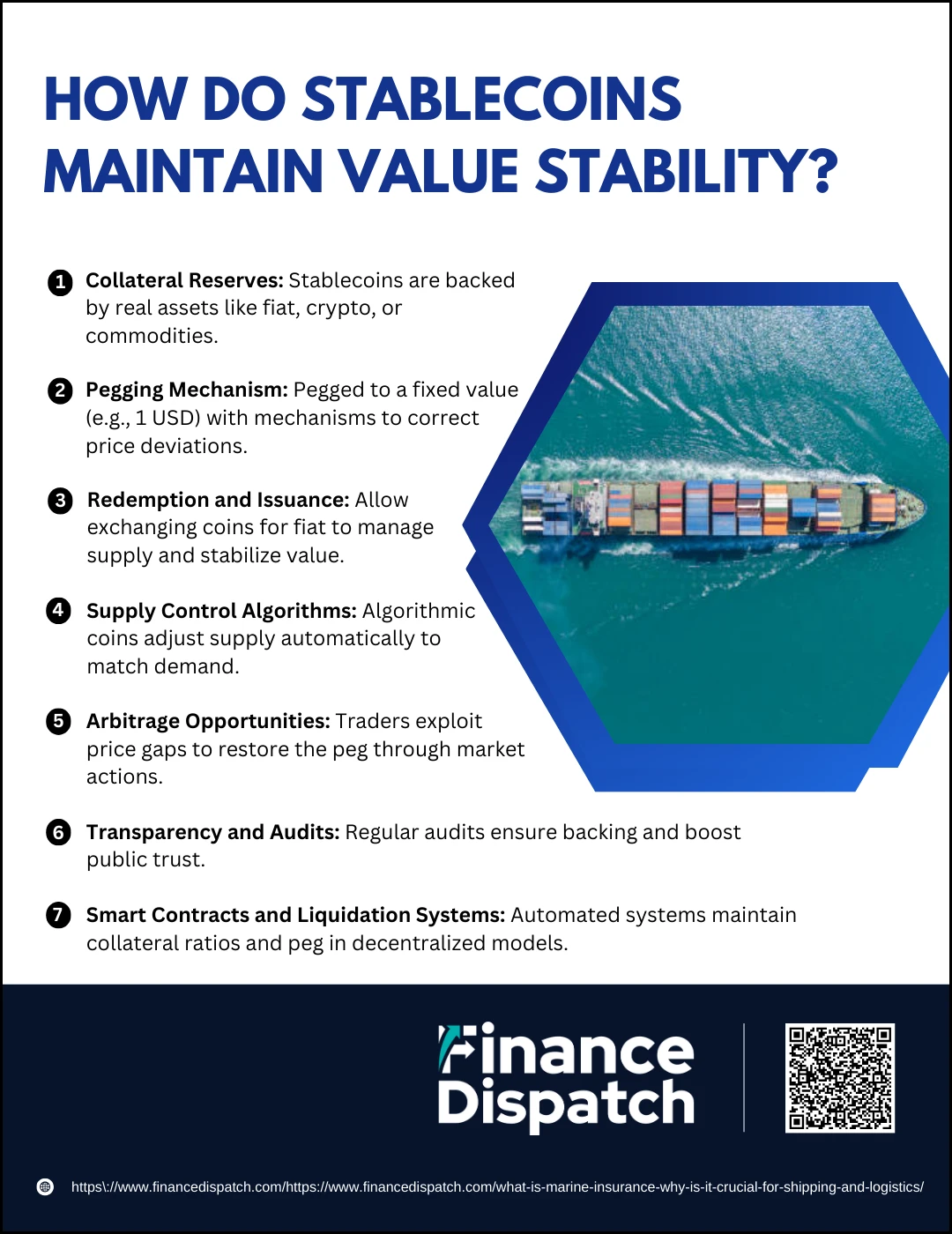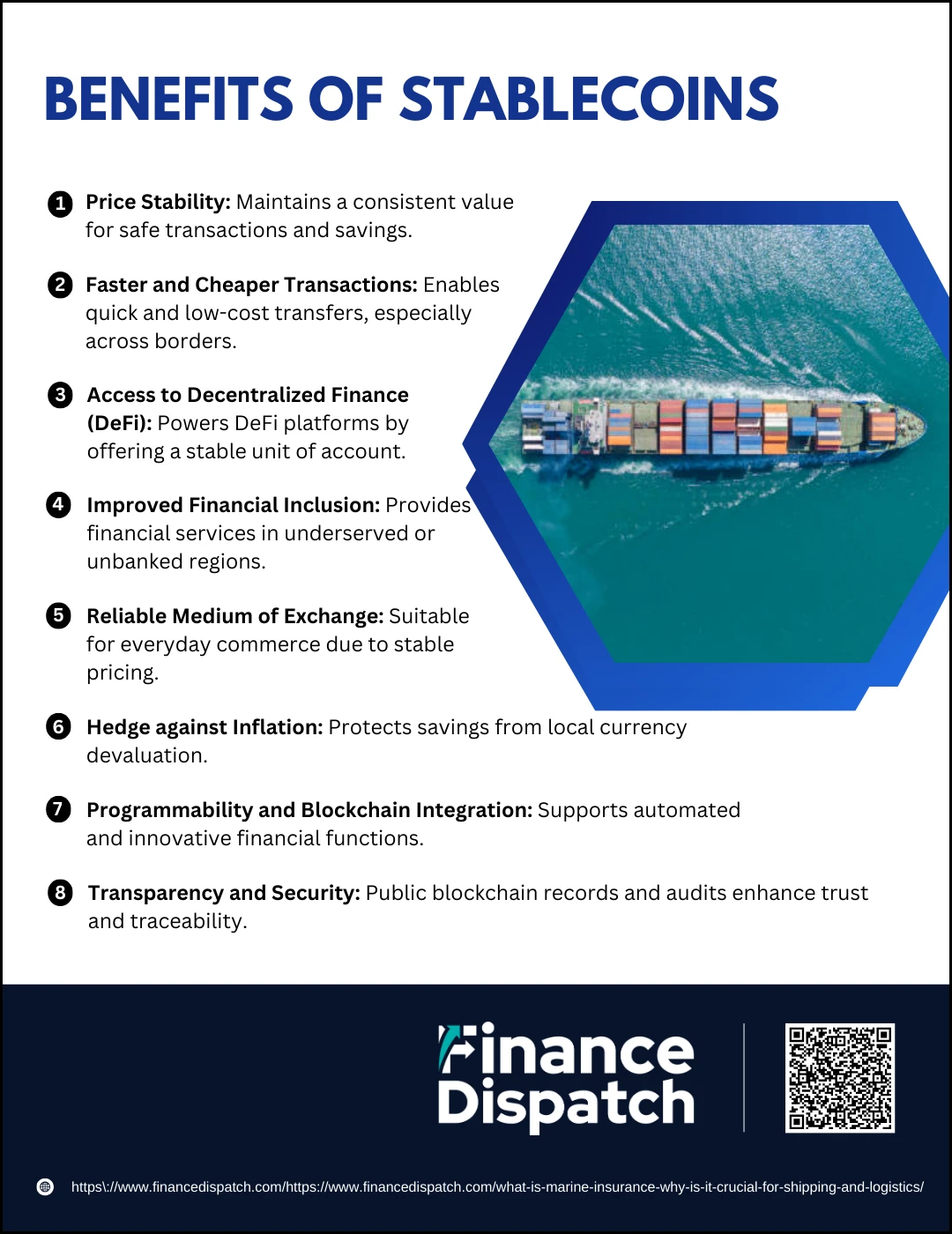Marine insurance is a vital safeguard in the world of global trade, offering financial protection against the unpredictable risks associated with transporting goods by sea and other modes connected to maritime routes. Whether it’s damage to cargo, accidents involving ships, or losses due to piracy or natural disasters, marine insurance ensures that businesses involved in shipping and logistics can recover from unforeseen incidents. As global supply chains grow increasingly complex, understanding what marine insurance is—and why it matters—has become essential for anyone navigating the challenges of international commerce.
What is a Stablecoin?
A stablecoin is a type of cryptocurrency designed to maintain a consistent value over time by pegging its worth to a stable asset, such as a fiat currency like the US dollar, a commodity like gold, or even another cryptocurrency. Unlike traditional cryptocurrencies such as Bitcoin or Ethereum, which are highly volatile, stablecoins aim to offer the price stability necessary for everyday transactions, savings, and use in decentralized finance (DeFi) applications. This stability is achieved through various mechanisms depending on the type of stablecoin, making them a crucial bridge between the predictability of traditional financial systems and the innovation of digital currencies.
 Types of Stablecoins
Types of Stablecoins
Stablecoins come in various forms, each using a different method to maintain price stability and gain users’ trust. These classifications are based on how the stablecoin is backed or how its value is managed. Understanding the types of stablecoins helps users evaluate their reliability, transparency, and risk.
1. Fiat-Collateralized Stablecoins
These are backed 1:1 by traditional fiat currencies like the US dollar or euro. For every stablecoin issued, an equivalent amount of fiat is held in reserve by a central entity. Examples include USDT (Tether) and USDC.
2. Crypto-Collateralized Stablecoins
These stablecoins are backed by other cryptocurrencies, often overcollateralized to absorb price volatility. Smart contracts manage the collateral and liquidation process. A well-known example is DAI, which is backed by Ethereum and other crypto assets.
3. Algorithmic Stablecoins
Instead of being backed by assets, algorithmic stablecoins rely on smart contract-based algorithms to expand or contract the coin’s supply to keep its price stable. was a prominent example of this model.
4. Commodity-Backed Stablecoins
These are backed by physical assets like gold or real estate. Their value corresponds to the price of the underlying commodity, offering a hedge against fiat currency inflation. PAX Gold (PAXG) is an example backed by gold.
5. Hybrid Stablecoins
Some stablecoins use a combination of methods, such as holding fiat reserves while also using smart contract algorithms to help maintain their peg. These aim to combine the benefits of transparency, decentralization, and security.
Why Stability Matters in Cryptocurrency
Stability is essential in cryptocurrency because it enables practical, everyday use and fosters trust among users, businesses, and investors. Traditional cryptocurrencies like Bitcoin and Ethereum are known for their price volatility, which makes them risky for routine transactions, savings, or long-term planning. This unpredictability can deter merchants from accepting crypto payments and users from holding assets over time. Stablecoins solve this problem by offering a reliable store of value, allowing for consistent pricing, easier cross-border payments, and integration into decentralized finance (DeFi) applications without the fear of sudden price swings. In essence, stability is what transforms cryptocurrency from a speculative asset into a usable financial tool.
 How Do Stablecoins Maintain Value Stability?
How Do Stablecoins Maintain Value Stability?
Stablecoins aim to combine the benefits of digital currencies with the reliability of traditional money by keeping their value stable, typically pegged to assets like the U.S. dollar. Unlike volatile cryptocurrencies such as Bitcoin or Ethereum, stablecoins use specific mechanisms to prevent wild price swings. These mechanisms vary depending on the type of stablecoin—whether it’s backed by fiat, crypto, or governed by algorithms—but all serve the same purpose: to keep the stablecoin’s value close to its peg. Below are the main strategies used to maintain this stability:
1. Collateral Reserves
Fiat- and crypto-backed stablecoins hold real assets in reserve. For every stablecoin issued, there’s an equivalent value held in cash, crypto, or commodities. These reserves provide a safety net, ensuring users can redeem their stablecoins at face value, which anchors the coin’s market price.
2. Pegging Mechanism
Stablecoins are usually pegged at a fixed rate (e.g., 1 stablecoin = 1 USD). When the price drifts above or below this peg, automatic or market-driven mechanisms are triggered to bring it back. This peg is crucial for maintaining trust in the stablecoin’s value.
3. Redemption and Issuance
Centralized stablecoins allow users to exchange coins for fiat currency. If the stablecoin trades below its peg, users can buy the discounted coin and redeem it for full value, removing excess supply. If it trades above the peg, more coins are issued to meet demand, pushing the price back down.
4. Supply Control Algorithms
Algorithmic stablecoins use smart contracts to automatically adjust supply based on demand. If prices rise, the system mints new coins to increase supply. If prices fall, coins are burned or incentives are given to reduce supply—bringing balance without physical collateral.
5. Arbitrage Opportunities
Traders exploit price gaps between stablecoins and their pegged assets. For example, if a stablecoin falls below $1, traders buy it cheaply and redeem it for a full dollar, driving the price back up. This constant buying and selling helps maintain price equilibrium.
6. Transparency and Audits
Trusted stablecoins regularly publish audits and reserve reports. These help assure the public that the coin is fully backed and managed responsibly. Greater transparency leads to higher confidence and price stability.
7. Smart Contracts and Liquidation Systems
In decentralized models like DAI, smart contracts automatically monitor collateral ratios. If the value of the collateral drops too low, assets are liquidated to preserve the peg. This ensures the system remains overcollateralized and solvent, keeping the coin’s value stable.
 Benefits of Stablecoins
Benefits of Stablecoins
Stablecoins play a vital role in the cryptocurrency ecosystem by offering the reliability of fiat currencies while maintaining the flexibility and efficiency of blockchain technology. Their key advantage is price stability, which makes them more practical for everyday use compared to volatile cryptocurrencies like Bitcoin. This stability makes stablecoins an essential tool for trading, saving, and accessing financial services in both centralized and decentralized systems. As adoption grows, stablecoins are increasingly used in real-world applications—from e-commerce and international remittances to decentralized lending and global payroll systems.
Here are the major benefits of stablecoins:
1. Price Stability
Stablecoins are specifically designed to hold a steady value, typically pegged to a fiat currency like the US dollar. This reduces the risk of value loss due to market volatility, making them ideal for use in daily transactions and savings.
2. Faster and Cheaper Transactions
Traditional international transfers can take days and involve high fees. Stablecoins settle transactions quickly—often within minutes—and with minimal costs, especially when compared to wire transfers or remittance services.
3. Access to Decentralized Finance (DeFi)
Stablecoins are the foundation of many DeFi platforms. They allow users to lend, borrow, earn interest, and trade without relying on a bank. Their stable value provides consistency, which is crucial in volatile crypto markets.
4. Improved Financial Inclusion
In areas with limited banking infrastructure or unstable national currencies, stablecoins give users access to secure, borderless financial tools using just a mobile phone and internet. They enable participation in the global economy without the need for traditional banking.
5. Reliable Medium of Exchange
Because their value doesn’t fluctuate dramatically, stablecoins are more suitable than other cryptocurrencies for regular commerce. Businesses and consumers can transact with confidence, knowing the value of the payment won’t change by the minute.
6. Hedge Against Inflation
In countries experiencing rapid currency devaluation, people often turn to stablecoins as a way to preserve their savings. By holding assets pegged to more stable foreign currencies, users can protect themselves from local economic instability.
7. Programmability and Blockchain Integration
Stablecoins can be easily integrated into smart contracts, enabling automated financial functions like recurring payments, payroll distribution, insurance claims, and escrow services. This opens up a wide range of innovative financial applications built on decentralized infrastructure.
8. Transparency and Security
Transactions involving stablecoins are recorded on public blockchains, offering transparency and traceability. Additionally, many reputable stablecoin issuers undergo regular audits to verify reserves, helping build user trust and security.
Risks and Limitations
While stablecoins offer many advantages, they are not without risks. Behind the promise of stability lies a range of vulnerabilities tied to how they are structured, governed, and used. These risks can affect users, issuers, and the broader financial ecosystem—especially when trust or collateral fails. Understanding the limitations of stablecoins is essential for anyone relying on them for savings, transactions, or decentralized finance activities.
1. Centralization Risks: Many fiat-backed stablecoins are issued and managed by centralized entities, meaning users must trust that the issuer truly holds the backing assets and will honor redemptions.
2. Lack of Transparency: Not all stablecoin issuers provide regular, verifiable audits of their reserves. This lack of clarity can raise doubts about the actual backing and solvency of the coin.
3. Smart Contract Vulnerabilities: Algorithmic and decentralized stablecoins rely on complex smart contracts, which may contain bugs or be exploited if not properly secured or audited.
4. Collateral Volatility: Crypto-collateralized stablecoins are exposed to price swings of their underlying assets. If collateral value drops rapidly, the system may fail to maintain the peg without timely liquidation.
5. Regulatory Uncertainty: Governments and financial regulators around the world are still defining their stance on stablecoins. Regulatory crackdowns could impact availability, legality, or use cases.
6. De-pegging Events: In cases where the mechanisms fail or market confidence collapses (as seen with some algorithmic stablecoins), the coin may lose its peg, resulting in rapid loss of value.
7. Liquidity Risks: If too many users try to redeem stablecoins at once and the issuer lacks immediate access to reserves, redemptions could be delayed or denied.
8. Limited Insurance or Protection: Unlike traditional bank deposits, stablecoin holdings are typically not insured. If something goes wrong, users may have limited recourse or legal protection.
Stablecoins vs. Fiat vs. Traditional Crypto
To understand where stablecoins fit within the broader financial landscape, it’s helpful to compare them with traditional fiat currencies and other cryptocurrencies like Bitcoin and Ethereum. Each of these has its own strengths and weaknesses in terms of stability, accessibility, regulation, and utility. The table below highlights key differences to illustrate how stablecoins aim to combine the reliability of fiat with the innovation of crypto.
| Feature | Stablecoins | Fiat Currency | Traditional Cryptocurrency |
| Price Stability | High (pegged to stable assets) | High | Low (subject to market volatility) |
| Decentralization | Varies by type | Centralized (government-issued) | Highly decentralized |
| Regulation | Partially regulated | Fully regulated | Minimally regulated |
| Transaction Speed | Fast (especially on blockchain) | Medium to slow | Fast |
| Global Accessibility | High (internet access needed) | Limited by borders and systems | High |
| Use in Payments | Growing in online/DeFi sectors | Widely accepted | Limited due to volatility |
| Transparency | Varies (some are audited) | Low (closed systems) | High (public blockchains) |
| Backing/Collateral | Pegged to fiat/crypto/commodities | Government trust and reserves | None (value based on demand) |
| Smart Contract Support | Yes (especially in DeFi use) | No | Yes |
Use Cases of Stablecoins
Stablecoins are more than just tools for holding digital dollars—they serve a wide range of practical purposes in the crypto ecosystem and beyond. Thanks to their stability, speed, and accessibility, they are increasingly used by individuals, businesses, and developers across various financial and non-financial applications. From enabling global payments to supporting decentralized applications, stablecoins offer real-world utility that extends far beyond simple trading.
1. Cross-Border Payments: Stablecoins allow users to send money internationally in minutes with lower fees compared to traditional remittance services or bank wires.
2. Trading and Arbitrage: Traders use stablecoins as a safe haven during volatile market conditions and to move funds quickly between exchanges for arbitrage opportunities.
3. DeFi Lending and Borrowing: In decentralized finance, stablecoins are commonly used as collateral for loans, or as the currency for earning interest through lending platforms.
4. Everyday Transactions: With growing merchant adoption, stablecoins are being used for online purchases, subscriptions, and in-store payments, especially in regions with unreliable local currencies.
5. Payroll and Compensation: Companies and freelancers use stablecoins to pay salaries globally, avoiding costly currency conversions and delays in banking systems.
6. Savings in High-Inflation Economies: In countries with unstable fiat currencies, individuals use USD-pegged stablecoins to protect their savings from local inflation or devaluation.
7.Automated Smart Contracts: Stablecoins are ideal for programmable payments in smart contracts, such as insurance payouts, recurring billing, or conditional transfers.
8. NFT and Gaming Economies: Some blockchain-based games and NFT platforms use stablecoins as an in-game or transactional currency to keep value consistent for users.
Future of Stablecoins
The future of stablecoins is poised to play a pivotal role in reshaping both traditional finance and the digital economy. As adoption grows, we can expect tighter regulatory frameworks aimed at improving transparency, consumer protection, and systemic stability—especially for fiat-backed stablecoins. At the same time, advancements in blockchain technology will enhance scalability, efficiency, and integration with global payment systems. Central banks are also exploring their own digital currencies (CBDCs), which may coexist or compete with stablecoins. In decentralized finance, stablecoins will likely remain the backbone of lending, trading, and savings platforms. As trust, regulation, and infrastructure continue to evolve, stablecoins are set to become foundational tools for secure, borderless, and programmable finance.
Conclusion
Stablecoins have emerged as a crucial innovation in the cryptocurrency space, offering the much-needed stability that traditional digital assets often lack. By combining the trust of fiat currencies with the speed, transparency, and flexibility of blockchain technology, stablecoins bridge the gap between conventional finance and decentralized ecosystems. Whether used for payments, savings, trading, or DeFi applications, they provide a reliable and accessible solution for users around the world. As the technology matures and regulations evolve, stablecoins are likely to become an integral part of the global financial system—reshaping how value is stored, transferred, and managed in the digital age.



